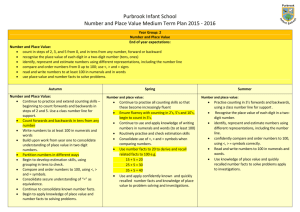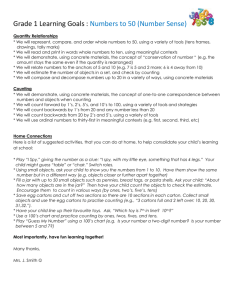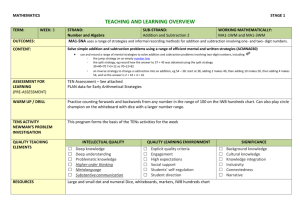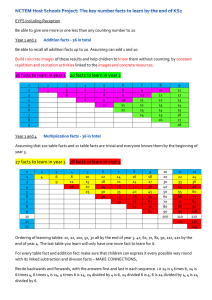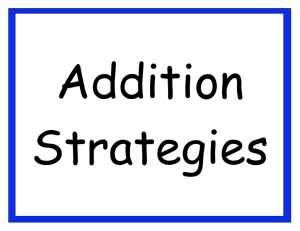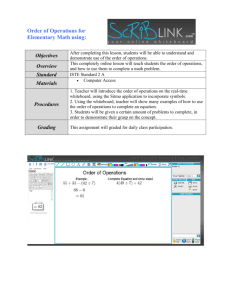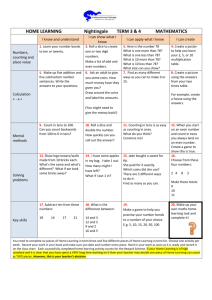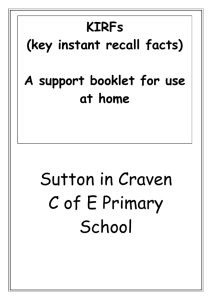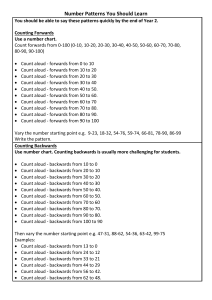PA - Stage 1 - Plan 8 - Glenmore Park Learning Alliance
advertisement
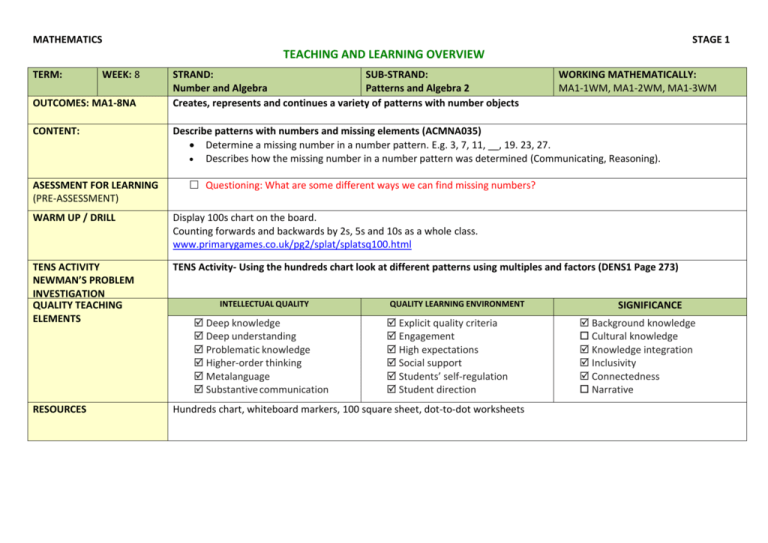
MATHEMATICS STAGE 1 TEACHING AND LEARNING OVERVIEW TERM: WEEK: 8 OUTCOMES: MA1-8NA CONTENT: ASESSMENT FOR LEARNING (PRE-ASSESSMENT) STRAND: SUB-STRAND: Number and Algebra Patterns and Algebra 2 Creates, represents and continues a variety of patterns with number objects WORKING MATHEMATICALLY: MA1-1WM, MA1-2WM, MA1-3WM Describe patterns with numbers and missing elements (ACMNA035) Determine a missing number in a number pattern. E.g. 3, 7, 11, __, 19. 23, 27. Describes how the missing number in a number pattern was determined (Communicating, Reasoning). Questioning: What are some different ways we can find missing numbers? WARM UP / DRILL Display 100s chart on the board. Counting forwards and backwards by 2s, 5s and 10s as a whole class. www.primarygames.co.uk/pg2/splat/splatsq100.html TENS ACTIVITY NEWMAN’S PROBLEM INVESTIGATION QUALITY TEACHING ELEMENTS TENS Activity- Using the hundreds chart look at different patterns using multiples and factors (DENS1 Page 273) RESOURCES Hundreds chart, whiteboard markers, 100 square sheet, dot-to-dot worksheets INTELLECTUAL QUALITY Deep knowledge Deep understanding Problematic knowledge Higher-order thinking Metalanguage Substantive communication QUALITY LEARNING ENVIRONMENT Explicit quality criteria Engagement High expectations Social support Students’ self-regulation Student direction SIGNIFICANCE Background knowledge Cultural knowledge Knowledge integration Inclusivity Connectedness Narrative TEACHING AND LEARNING EXPERIENCES WHOLE CLASS INSTRUCTION MODELLED ACTIVITIES GUIDED & INDEPENDENT ACTIVITIES Make up numeral cards that have a variety of numbers from 0-100 on them. Hold them up and ask for students to tell you as quickly as possible the number that comes before/after the number of the card you holding up. You can turn this into a competition between two teams to make it more interesting for the students. It is also possible to play the game asking for the number that is two or five numbers before/after the given number. LEARNING SEQUENCE 22 30 29 28 Rule; ______________ 25 0 2 4 Rule: _______________ 10 Looking for Patterns Write 1, 2, 3 on the board. Ask children to continue the counting pattern. Write the next few numbers on the board. What is the pattern? Write 10, 12, 14 on the board. Ask children to continue the counting pattern. Write the next few numbers. What is the pattern? Write other examples of counting by 2s, 3s and 5s. Children identify the pattern and continue it for another four turns. Patterns Give students photocopies of 100 squares and get them to colour a number from 1-10. Then they decide what pattern they are going to use, e.g. start on 2 and count by 3s. They colour each number that they land on. Look at the patterns. Discuss the patterns. Investigation: Adapt dot-to-dots. Change the numbers and the starting number to given children practice counting in 2s, 3s or 5s. Photocopy them for children to solve. 23 14 15 20 25 35 Rule: _______________ 50 96 94 90 88 Rule: _______________ 82 Discuss what is happening in each pattern. Is it going forwards or backwards? By how many? Repeat with further examples. Remediation ES1 S1 Display on the whiteboard the following problems: 15 16 17 19 Rule: _____________ LEARNING SEQUENCE LEARNING SEQUENCE Extension Early S2 EVALUATION & REFLECTION Divide students into pairs. Give each pair a laminated hundreds chart that they can draw on with a whiteboard marker. Have students circle the number 5 and then keep circling by 5s. Can students see a pattern? What tells them that a number is going to be circled? Can students predict the numbers? Students then wipe their board’s clean and repeat activity using other numbers. When students have an understanding of the concept get them to count forwards/backwards by 2s from 55. Were students able to identify patterns? Could students provide reasons for their responses and continue the patterns? All assessment tasks should be written in red and planning should be based around developing the skills to complete that task. Assessment rubrics or marking scale should be considered.



